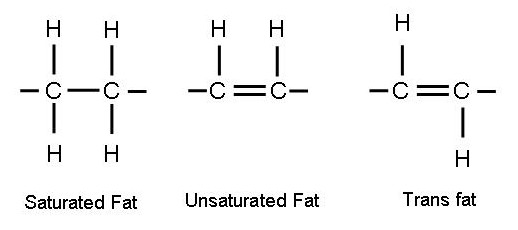|
Definition
of trans fat
Trans
fat is a specific type of fat formed when liquid fats
are made into solid fats by the addition of hydrogen
atoms, in a process strangely enough known as hydrogenation.
That being said, small amounts of trans fats are found
naturally in certain animal based foods. Trans fat was
originally added to foods to increase the shelf life.
Trans fat does not stand for "Transformed fat"
(except maybe in the mind of someone trying to market
this), but comes from the fact that the hydrogen atoms
in the double bond are actually across from each other
(see below). This comes from the Latin meaning of trans,
which is across.

The
FDA has estimated that the average American consumes
5.8 grams of trans fat per day!
What
are the health effects of trans fat?
An
Institute of Medicine/National Acadamies of Science
report recently recommended that "trans fatty acid
consumption be as low as possible while consuming a
nutritionally adequate diet." Trans fat gives a
double dose of bad news, as it increases so-called bad
cholesterol, which is actually Low Density Lipoprotein
(LDL) and decreases so-called good cholesterol, which
is actually high density lipoprotein (HDL). Most experts
agree that it is the ratio of LDL to HDL which determines
your risk factor for heart disease, so it is good for
anyone interested in a healthful diet to reduce the
intake of trans fat. Other types of fat have not been
shown to decrease HDL, but saturated fats have been
shown to increase LDL. It is advisable to decrease the
daily intake of saturated fat AND trans fat and not
give up by increasing the other.
One
thing to remember is that there is no daily recomended
value for trans fat. It potentially is required in small
amounts in our diet, but certainly not at 5.8 grams
per day!
Truth
in Advertising?
In
the current FDA rule trans fat does not have to be listed
if the total fat in a food is less that 0.5 grams per
serving and no claims are made about the fat, fatty
acids or cholesterol content. The result of this rule
is that you could consume up to 0.49 grams per serving
and think you are being good to yourself. I picked up
some chips at the supermarket, and they actually had
a label on the front advertising "0 grams trans
fat" and I bought them only to get home and realize
that partially hydrogenated soybean oil was on the ingredients
list! What to do? Read the ingredients and look for
the word "shortening" or the words "hydrogenated"
or "partially-hydrogenated."
If
below the threshold of 0.5 grams, a footnote will be
on the label stating that the food is not a significant
source of trans fat. If the daily value and the extent
of health risk due to trans fat consumption is not defined
then how can it be defined as "not a significant
source"? What is the context for that statement?
Steps
to minimize the amount of trans fat in your diet
Here
are some simple steps you can take to minimize the amount
of trans-fat in your diet:
- Read
the label and compare foods - This is not always as
easy as you think as the current rules may allow a
manufacturer to label as 0g transfat on the label,
when there are actually up to 0.49g per serving (see
below).
- Switch
to monounsaturated fat and polyunsaturated fat. These
fats are found in oils (olive, canola, and others)
and nuts. These fats not only do not raise LDL, but
have health benifits when consumed in moderation.
A related suggestion is to switch to vegtabale oils.
I use olive oil when cooking and usually corn or sunflower
oil for everything else.
- Many
processed and ready to prepare foods contain trans
fat, such as microwave popcorn. If you use corn oil
and a large pan on the stove, it tastes better anyway...
Links
for more information:
Trans
Fatty Acids in Nutrition Labeling, Nutrient Content
Claims, and Health Claims - FDA final rule
Ban
Trans Fats - The Campaign to Ban Partially Hydrogenated
Oils
| 
